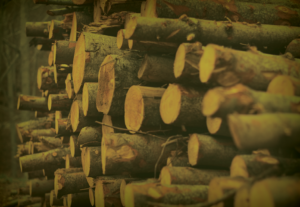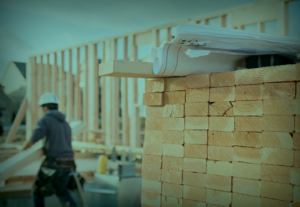How often do you hear about a new building material being used where the end product has the potential to make your employees happy, be better for the environment, and possibly cheaper to construct? What product am I talking about? Mass timber!
Mass timber are big, beautiful structures that have the potential to have environmental benefits (although, more research needs to be done). In fact, after being constructed in Europe and Canada for years, mass timber projects are gaining in popularity and making headlines across the U.S. So much so, that as of September of 2019, there were 664 mass timber projects built, started, or in design in 48 states.
What is Mass Timber?
It sounds fairly easy to figure out, but I thought it would be helpful for a quick definition before I get too far. Mass timber is a family of engineered wood products that uses small wood members formed into large panelized wood, engineered to minimize the natural inconsistencies found in wood and structurally created in multiple layers to achieve greater strength than traditional lumber.
The 4 Types of Mass Timber
When it comes to mass timber, not all of it is created equal. There are various types:
- Cross-laminated timber (CLT) is an engineered wood panel typically consisting of three, five, or seven layers of dimension lumber oriented at right angles to one another and then glued to form structural panels with exceptional strength, dimensional stability, and rigidity.
- Nail-laminated timber (NLT) is created by fastening individual dimensional lumber (2×4, 2×6, 2×8, 2×10 or 2×12), stacked on edge, into one structural element with nails.
- Glue-laminated timber (glulam) is composed of individual wood laminations (dimension lumber), specifically selected and positioned based on their performance characteristics, and then bonded together with durable, moisture-resistant adhesives.
- Dowel-laminated timber (DLT) is the only all wood mass timber product. It can be used for floor, wall, and roof structures. Hardwood dowels are used to friction fit pre-milled boards together on the edge, creating a panel which is particularly efficient for horizontal spans and allows for much architectural flexibility.

What are Mass Timber Advantages?
So, what are the advantages of using mass timber? There are several. Here are just a few:
- Accelerated Construction Time — Of the mass timber products, CLT appears to be the product of choice in the U.S. Experts contend that construction time is accelerated due to panels being prefabricated off-site and then assembled on-site, boasting a 25 percent quicker build than a similar concrete structure.
- Injury Reduction — The quantity of workers and construction traffic at the job site are reduced, which can reduce injuries and accidents.
- Strength of Product —There is also an abundance of research demonstrating these buildings are strong. They weigh approximately 1/5 less than a similar concrete building. A high strength-to-weight ratio enables mass timber to perform well during seismic activity.
- Planet Friendly — Reducing the carbon footprint is a priority for many organizations, and, although there is still debate of over how sustainable the new building material is, it does show promise as a way to sequester massive amounts of CO2, if a fully sustainable life cycle comes together. Forest management is a major piece to this puzzled discussion. Concrete accounts for a potential 8 percent of global emissions of greenhouse gasses. CO2 emissions are estimated to be reduced by 15 percent using mass timber construction versus steel. Another important factor contributing to this movement is that CLT buildings are recyclable once they reach their end of use. We’d be remiss if we didn’t discuss the feeling people have of being part of a structure that is not only aesthetically pleasing, but that could be contributing to the well-being of the planet.
Mass Timber Risks
As with all products, there are also some risks when it comes to mass timber.
Fire Resistance
Fire resistance is a primary risk associated with mass timber construction. And, why not? Combustible materials have long been a concern when constructing high rise buildings.
Current building codes in the U.S. don’t allow for construction over six stories, so it’s been imperative for owners building today to get a performance workaround requiring costly testing to prove to local authorities that mass timber products can perform equal to or better than steel and concrete products.
However, after extensive fire testing, it’s been confirmed that mass timber structures meet, and may exceed, the fire resistance requirement in the current code and in 2021 International Building Code (IBC) with new provisions. There are three new types of construction which set requirements for fire safety, allowable heights, and number of stories.
Water Damage
Water is another risk resulting in property damage associated with this type of construction. Engineered wood products can hide moisture for years, and this has the potential to cause strength issues in the building. Special care and property risk management procedures during construction and when the building is operational are important for the integrity of the structure.

Insurance Considerations When Building with Mass Timber
Underwriting considerations for mass timber will have additional focus areas, such as building materials, source of the material, types of wood adhesives used, moisture content of the wood, construction sequencing, combustibility and fire resistance, performance under wind and seismic stress, and insect and pest exposures.
In addition, expect to have significant discussions on the presence and effectiveness of automatic fire sprinkler systems, ability to withstand water damage and mold/fungus exposures (during and after construction), cost to replace, long-term performance, experience of the contractors, potential issues in sequencing and scheduling, size of panels, transportation and delivery of panels, and any risk mitigation efforts.
If you’d like more information on this topic and how insurance will work if you’re considering using mass timber, don’t hesitate to reach out to us. We have a knowledgeable team on hand who can help!



